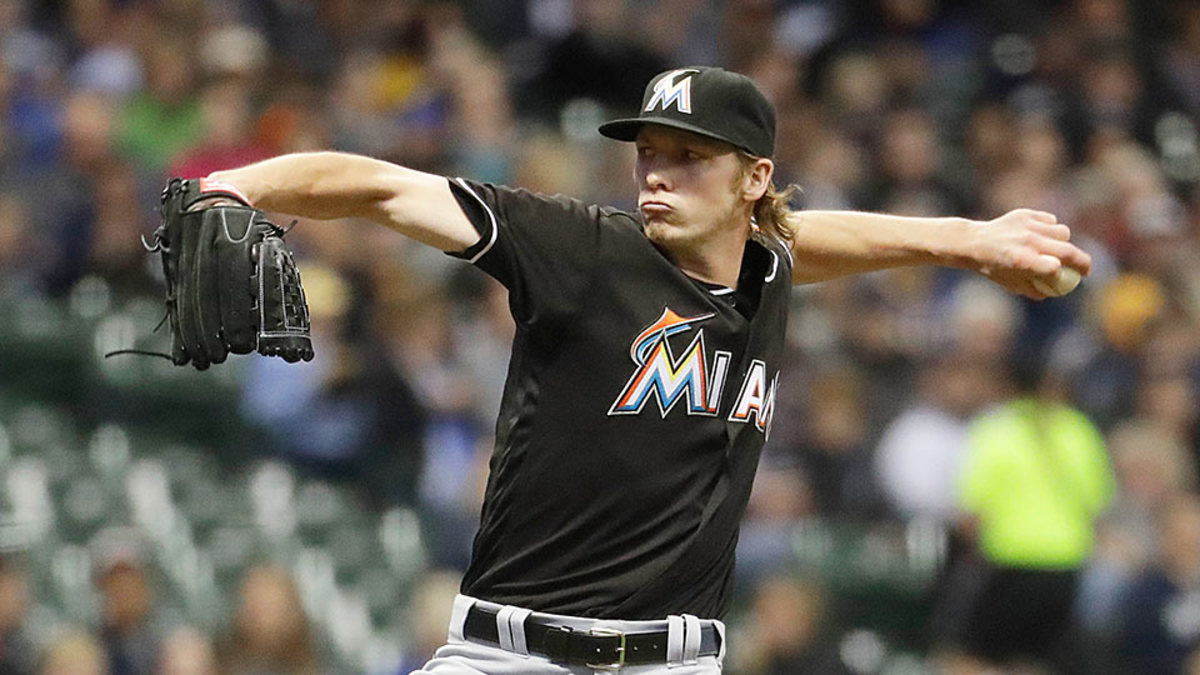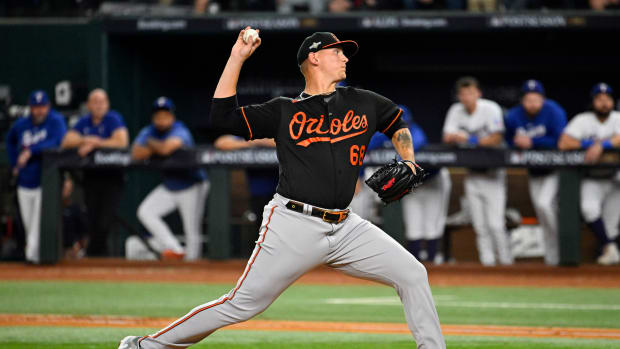Mattingly wise to protect Conley, rightly pulls him despite no-hit bid
Get all of Cliff Corcoran’s columns as soon as they’re published. Download the new Sports Illustrated app (iOS or Android) and personalize your experience by following your favorite teams and SI writers.
Hernan Perez’s fly ball fell safely into the glove of Marlins centerfielder Marcell Ozuna for the second out in the bottom of the eighth inning at Milwaukee’s Miller Park Friday night. Adam Conley, the Marlins’ sophomore lefty making just his 16th major-league start, had scattered four walks and struck out seven Brewers on the night but had not allowed a hit. Just four more outs stood between the lanky, long-haired 25-year-old and a distinguished place in baseball’s record book. However, the pitch that Perez hit to Ozuna would be Conley’s last of the night.
Conley wasn’t hurt. Miami’s 5–0 lead was in no immediate danger with two outs despite the runner on first base via Conley’s fourth walk. Instead, Conley came out because of his pitch count. That last pitch was Conley’s 116th. Conley had not thrown more than 95 pitches in any of his four previous starts on the season, one of which lasted just one inning due to a long rain delay, and had reached 100 pitches just once after July 1 last season, when he threw 106 against the Phillies on Aug. 23. The most pitches he had thrown in a single game since being drafted in the second round by the Marlins in 2011 was 108, which came on May 19 of last year. Conley was already eight pitches past that point, had four more outs to go and had needed 15 pitches just to get the first two outs of the eighth inning.
#http://www.120sports.com/video/v175392928/conley-on-near-nohitter
At the rate he was going, Conley was going to sail past 130 pitches in the ninth inning. Marlins manager Don Mattingly wasn’t about to let that happen, so he removed Conley from the game four outs shy of a potential no-hitter, knowing full well that it would be an unpopular move. Like Dave Roberts, who replaced Mattingly at the helm of the Dodgers, removed rookie Ross Stripling after 7 1/3 no-hit innings and 100 pitches in Striplings’s major-league debut on April 8, Mattingly placed Conley’s health above his pitcher’s chance to complete a noteworthy but ultimately trivial performance.
Inside Dee Gordon's PED ban, and what real penalty should be
As a result, Conley and Stripling now hold an even more unique place in baseball history. They are two of just three starting pitchers to be removed from a game with the lead or tied after the seventh inning despite not giving up a hit. The third was Pirates righty Francisco Cordova, who threw 121 pitches over nine no-hit innings on July 12, 1997, but didn’t receive a run of support from his team. Cordova was replaced in the 10th inning by lefty Ricardo Rincon, who worked a hitless frame of his own, and Mark Smith hit a three-run pinch-hit home run in the bottom of the 10th to clinch the combined no-hitter. Neither Conley nor Striplings’s teammates were able to keep the no-hitters they inherited intact. The Dodgers, who were leading 2–0 when Stripling was removed following a one-out walk in the eighth, blew the no-hitter and the game, losing 3–2 to the Giants. The Marlins won, but only after giving up three runs and putting the tying run on base in the bottom of the ninth and setting the final score at 6–3.
It may seem like heresy, but no-hitters are ultimately statistical quirks. Yes, they are evidence of an impressive pitching performance lasting at least nine innings, but would Conley’s performance on Friday night have been any less impressive had he walked no one and scattered four seeing-eye singles, or, for that matter, wouldn’t it have been more impressive if he had allowed one well-struck hit but walked no one? If he had done that, he may have had enough leeway in his pitch count to pitch the ninth inning.
Indeed, not all no-hitters are created equal. Former Marlin A.J. Burnett headed into retirement last fall embarrassed that the nine walks he issued on May 12, 2001 still stood as the most ever in a no-hitter. Nine years later, in June 2010, Edwin Jackson walked eight men and threw 149 pitches in the course of no-hitting the Rays. No major leaguer has thrown that many pitches in a game since. In fact, Tim Lincecum, who threw 148 pitches in the course of no-hitting the Padres for the first time in 2013, is the only other pitcher to reach the 140-pitch threshold since 2005. Conley wasn’t going to become the next man to do it.
Gordon's PED suspension proves we know nothing about steroid users
For all the things we don’t know about how best to condition and protect pitchers’ arms, it takes little more than common sense to understand that fatigue makes pitchers more susceptible to injury, just as fatigue makes all athletes more susceptible to injury. A stressed muscle, ligament or joint is more likely to give out. What exactly results in fatigue can change from pitcher to pitcher and start to start. Fifty pitches over five innings shouldn’t result in fatigue for any major league starting pitcher, but 50 pitches in a single inning rings all sorts of alarm bells. A pitcher struggling through multiple long, stressful innings can feel fatigued before reaching 90 pitches, whereas another pitcher can average 14 pitches per inning with a big lead and very little traffic on the bases and pass 110 pitches without much fatigue at all.
Two other crucial factors are age and conditioning, though only one of those is actually relevant to Conley and Stripling. With regard to age, young men, particularly tall young men like Conley and Stripling, each listed at 6'3", commonly continue to grow into their late teenage years and some continue to grow into their early 20s. As such, most pitchers’ bodies are still developing in their early 20s, either by continuing to add height or by filling out their frame and musculature. As a result, pitchers under the age of 25 are considered to have an elevated injury risk. However, Conley and Stripling are past that cutoff. Stripling turned 26 in November, while Conley will turn 26 next month. So biological youth wasn’t necessarily a significant risk factor for either. What was, however, was their baseball youth, which is to say, their relative lack of experience and conditioning.
As stated above, Conley, a sophomore with just 16 major-league starts under his belt, is unaccustomed to surpassing 100 pitches in a start and has never reached 110 pitches, never mind the 120 he was barreling toward in the eighth inning Friday night. Similarly, when Stripling reached 100 pitches in his major-league debut, it was the first time in his professional career he had thrown that many pitches in a game. Neither pitcher was conditioned to pitch any deeper into a game, and with their no-hit bids coming so early in April, there hasn’t been time for their teams to stretch them out this season. Doing so under the accumulating stress of pursuing a no-hitter would only have compounded the risk.
Yes, it’s entirely possible that, if left in the game, both pitchers could have gotten a few quick outs, recorded their no-hitter with fewer than 120, or in Conley’s case, 130 pitches thrown, and never experienced any long-term consequences from having done so. However, Roberts and Mattingly correctly decided that the reward for leaving their pitchers in didn’t come anywhere close to balancing out the risk of doing so.
Neither Conley nor Stripling is an elite prospect. However, with the Dodgers’ rotation already hit hard by injuries to Hyun-Jin Ryu, Brandon McCarthy, Brett Anderson and Michael Bolsinger, Los Angeles couldn’t take a risk with Stripling. Conley, meanwhile, is a promising, young, team-controlled arm in an organization that failed to place a single prospect on Baseball America, Baseball Prospectus, MLB.com or ESPN’s top 100 prospect lists in February, lost top pitching prospect Tyler Kolek to Tommy John surgery earlier this month and isn’t sure how long it can afford to keep young ace Jose Fernandez, who will be arbitration eligible next winter.
Healthy, young, cost-controlled pitching is arguably the most valuable commodity in baseball. Putting it at risk for a chance at the 296th no-hitter in major-league history would have been irresponsible even if those organizations had deeper, healthier rotations. Indeed, after Friday night’s game, Mattingly described the decision to remove Conley as “easy.”
MLB April All-Stars: Harper, Machado, Syndergaard lead month's best
“This kid has a chance to be really special,” Mattingly said. “So, there’s no way, at this point in the season, that we’re going to let him go to 130. We know we have a long season and we feel like we have a chance to go somewhere. He’s going to have to be a part of that so we have to protect him.”
Said Roberts, the day after Stripling’s debut: “Everyone wants the story ... I wanted to see him throw a no-hitter. It’s a special moment. But we’re looking at the long term. We’re looking at the long view. Ross can help us win many more games. If it would have gone south and something would have happened, I would have never been able to live with myself. Because this is this kid’s livelihood. That’s my job.”
Specifically, his job, and Mattingly’s, and that of every other manager, is to win games, not just tonight’s game, but as many games as possible over a 162-game season and, ideally, over the course of multiple seasons. Pushing an inexperienced starter past the point of fatigue for the sake of an individual accomplishment runs counter to those goals. Mattingly made the right decision Friday night, as did Roberts four weeks earlier, and with those examples in hand, hopefully it will be easier for the next manager faced with that unenviable decision to do the same.




































